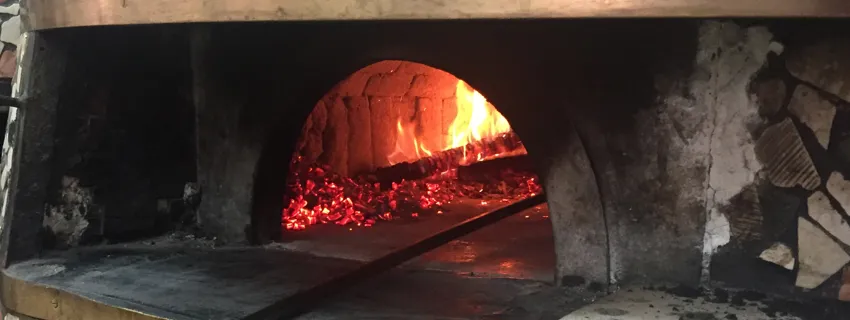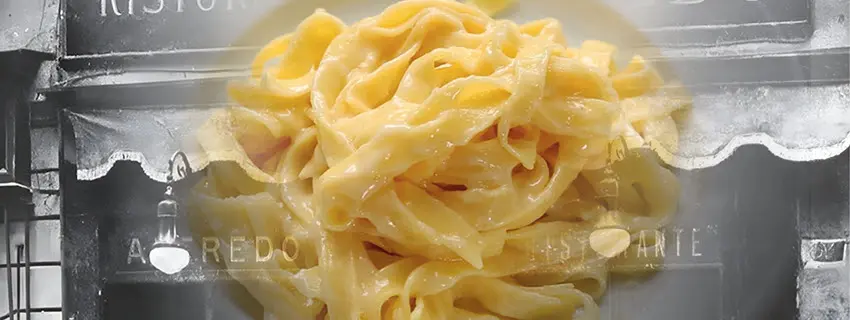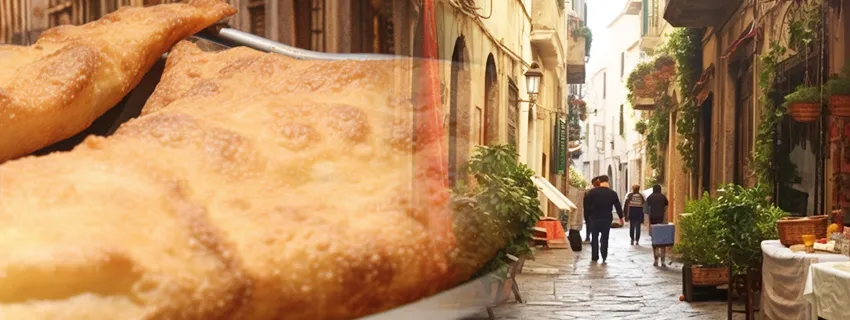Published:
Author: Antonio Maria Guerra
Italian First Courses
The Most Typical Specialties

Welcome! This section of WebFoodCulture is dedicated to the most typical first courses of the Italian gastronomy. We will explain what makes them so special and inimitable, starting with their history and places of origin, all seasoned with a large number of curiosities. Finally, we will discover the most traditional restaurants and producers, thanks to which it will be possible to savor the most authentic taste of these delicacies. Enjoy the reading!
Italy is so rich in delicacies that some are little known to Italians themselves. Such is the case with Fettuccine Alfredo: a specialty ‘made in Rome’, but considered by some ‘made in USA’. Let’s discover this great dish!
(read more)
Origin: Rome (Lazio) Typology: First Courses
Last update
The history of Fettuccine Alfredo: a beautiful made of fettuccine, butter and Parmesan cheese. A story steeped in love, culinary mastery and, above all, the ability to create masterpieces of taste using just a few ingredients.
(read more)

Ultimo aggiornamento
Let’s discover the reasons for the success of casatiello, the Neapolitan Easter specialty, starting with a brief look at its recipe, before exploring its variations, pairings, nutritional values, and much much more. (read more)
Origin: Naples (Campania)
Tipologia: Primi Piatti
It’s possible that the origins of Casatiello, the Neapolitan savory cake, date back to classical times. Let’s find out the history of a specialty that, thanks to its rich religious symbolism, has become a must at Easter. (read more)
Origin: Naples (Campania)
Tipologia: Primi Piatti
Among the many hypotheses regarding the origins of the name ‘Casatiello’, the one currently considered most convincing has it derived from the Latin word ‘caseus’, which, translated in English, means ‘cheese’. So, it is no coincidence that cheese itself is among the main ingredients of the specialty. (read more)
Ultimo aggiornamento
It’s impossible to deny that the very moment one hears of Sicilian cuisine, arancini immediately come to mind: this rice-based specialty, in fact, sums up the taste, aroma and colors of the exuberant culinary tradition of the Italian island. (read more)
Origin: Palermo / Catania (Sicily)
Typology: First Courses / Street Food
Arancino or arancina? Which is the correct name for the famous Sicilian specialty?
A doubt that, over time, has started heated discussions. Let’s try to shed some light on the matter. (read more)
Origin: Palermo / Catania (Sicily)
Typology: First Courses / Street Food
Few people know that Margherita pizza, the famous Neapolitan speciality, takes its name from that of a real queen: Margherita of Savoy.
Let’s find out the secrets of this classic of taste.
(read more)
Origin: Naples (Campania)
Typology: First Courses
Even of specialties quite similar to fried pizza can be found in many parts of the world, the one that can be eaten in Naples has unique characteristics, largely related to the particular nature of the city: peculiarities that make it special and inimitable.
(read more)
Origin: Naples (Campania)
Typology: First Courses / Street Food
Although the ideal place to enjoy an arancino is, without any doubt, Sicily, it’s important to stress the fact that it’s possible to savor this delicacy also in the rest of Italy and in many places around the world. This is due to emigration that, mainly in the past, led many Sicilians to relocate abroad.
(read more)

Fried pizza is one of the most typical specialties from Naples: it’s possible to say that, in a way, it sums up its spirit. (read more)
Although pasta Carbonara cannot boast very ancient origins, it’s considered very traditional. This is because it represents the perfect synthesis of a culinary sensibility matured over the centuries in a precise geographical area. (read more)
Origin: Italy (Lazio) Typology: First Courses
Nowadays the use of cream in the preparation of Carbonara pasta is considered a kind of heresy by many fans of this specialty. (read more)
Cous Cous is generally considered the quintessential Arab gastronomic specialty. There is no doubt about its deep connection with the desert and its people: those Berber nomads who in ancient times invented a food that was easy to transport and quick to cook. (read more)
Origin: Maghreb Typology: First Courses
Specialties from the world
It’s quite possible that the origins of the name ‘Couscous’, as well as those of the specialty, are Berber. (read more)
Copyright information.
The images displayed in this page belong to WebFoodCulture.















